
Global pharmaceutical company Eli Lilly (NYSE: LLY) met Wall Street’s revenue expectations in Q4 CY2024, with sales up 44.7% year on year to $13.53 billion. The company’s full-year revenue guidance of $59.5 billion at the midpoint came in 1% above analysts’ estimates. Its non-GAAP profit of $5.32 per share was 4.7% above analysts’ consensus estimates.
Is now the time to buy Eli Lilly? Find out by accessing our full research report, it’s free.
Eli Lilly (LLY) Q4 CY2024 Highlights:
- Revenue: $13.53 billion vs analyst estimates of $13.56 billion (44.7% year-on-year growth, in line)
- Adjusted EPS: $5.32 vs analyst estimates of $5.08 (4.7% beat)
- Management’s revenue guidance for the upcoming financial year 2025 is $59.5 billion at the midpoint, beating analyst estimates by 1% and implying 32.1% growth (vs 31.8% in FY2024)
- Adjusted EPS guidance for the upcoming financial year 2025 is $23.25 at the midpoint, beating analyst estimates by 2.5%
- Operating Margin: 38%, up from 25.5% in the same quarter last year
- Market Capitalization: $758.3 billion
"2024 was a highly successful year for Lilly," said David A. Ricks, Lilly's chair and CEO.
Company Overview
Founded in 1876, Eli Lilly (NYSE: LLY) is a global pharmaceutical company that develops and produces a wide range of medicines and vaccines for medical conditions such as diabetes, cancer, and mental health disorders.
Branded Pharmaceuticals
The branded pharmaceutical industry relies on a high-cost, high-reward business model, driven by substantial investments in research and development to create innovative, patent-protected drugs. Successful products can generate significant revenue streams over their patent life, and the larger a roster of drugs, the stronger a moat a company enjoys. However, the business model is inherently risky, with high failure rates during clinical trials, lengthy regulatory approval processes, and intense competition from generic and biosimilar manufacturers once patents expire. These challenges, combined with scrutiny over drug pricing, create a complex operating environment. Looking ahead, the industry is positioned for tailwinds from advancements in precision medicine, increasing adoption of AI to enhance drug development efficiency, and growing global demand for treatments addressing chronic and rare diseases. However, headwinds include heightened regulatory scrutiny, pricing pressures from governments and insurers, and the looming patent cliffs for key blockbuster drugs. Patent cliffs bring about competition from generics, forcing branded pharmaceutical companies back to the drawing board to find the next big thing.
Sales Growth
Examining a company’s long-term performance can provide clues about its quality. Any business can put up a good quarter or two, but the best consistently grow over the long haul. Over the last five years, Eli Lilly grew its sales at a solid 15.1% compounded annual growth rate. Its growth surpassed the average healthcare company and shows its offerings resonate with customers, a great starting point for our analysis.
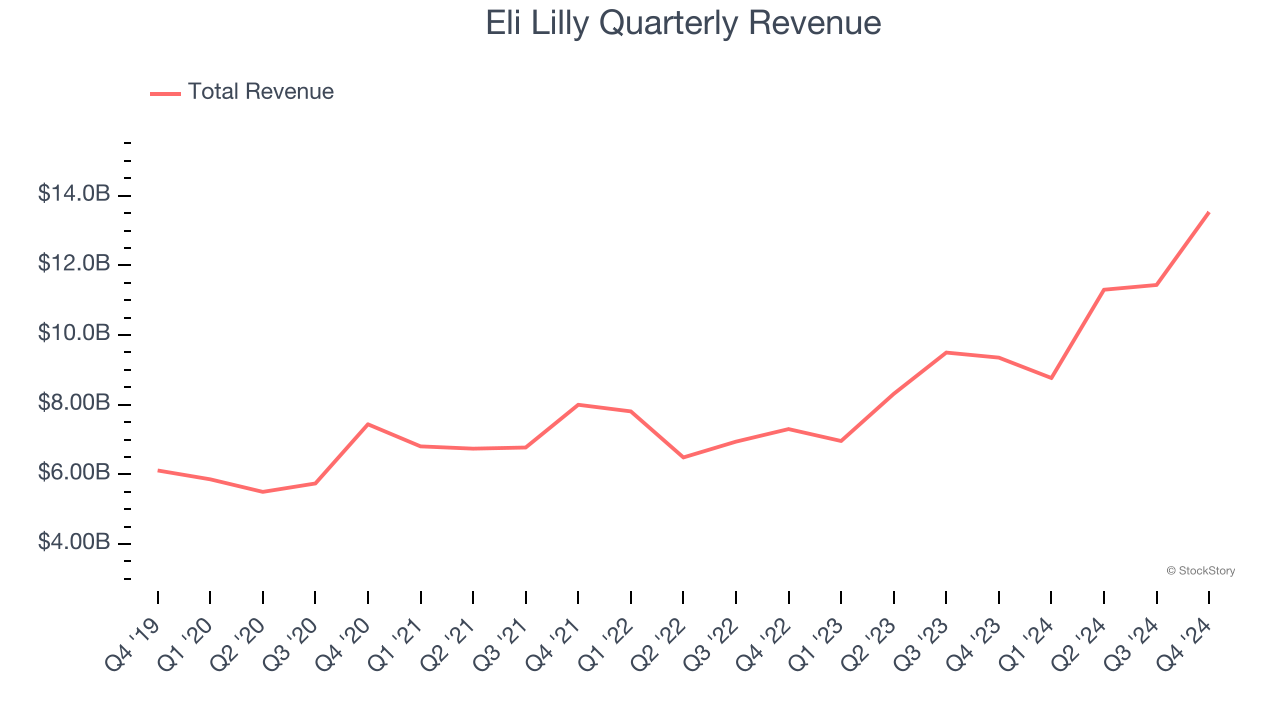
Long-term growth is the most important, but within healthcare, a half-decade historical view may miss new innovations or demand cycles. Eli Lilly’s annualized revenue growth of 25.6% over the last two years is above its five-year trend, suggesting its demand was strong and recently accelerated. 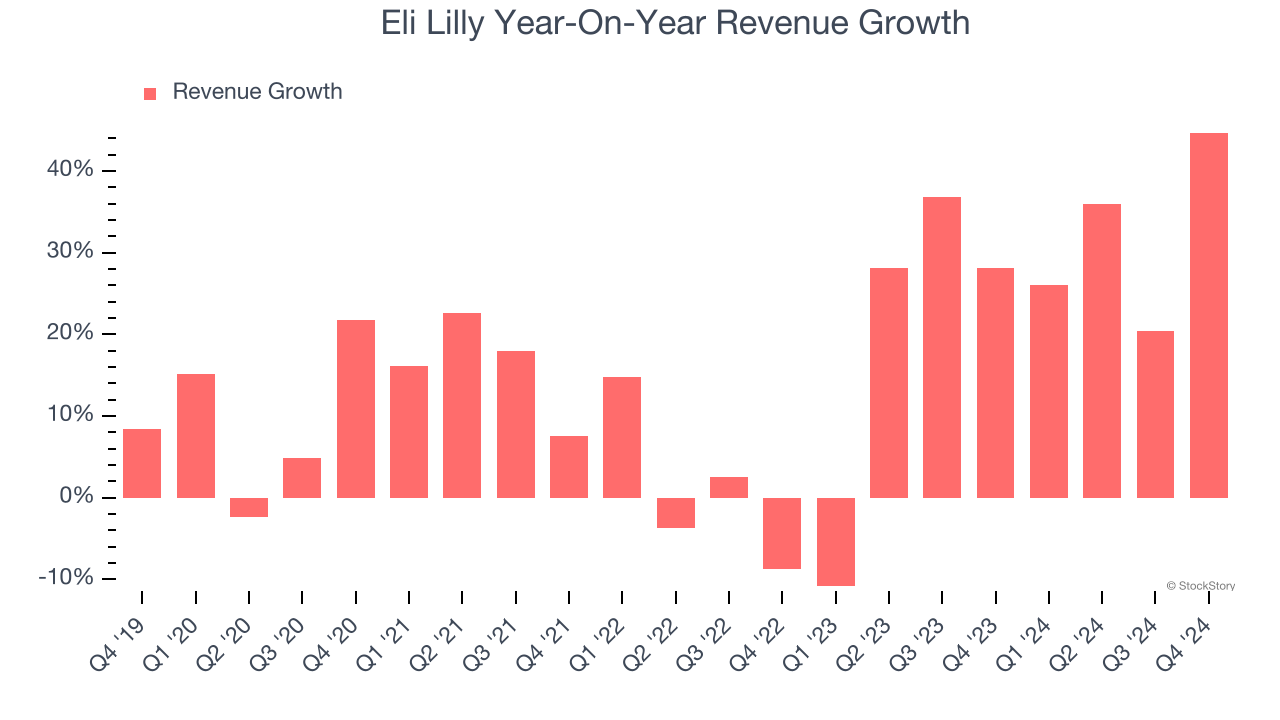
This quarter, Eli Lilly’s year-on-year revenue growth of 44.7% was magnificent, and its $13.53 billion of revenue was in line with Wall Street’s estimates.
Looking ahead, sell-side analysts expect revenue to grow 32% over the next 12 months, an improvement versus the last two years. This projection is eye-popping for a company of its scale and suggests its newer products and services will catalyze better top-line performance.
Software is eating the world and there is virtually no industry left that has been untouched by it. That drives increasing demand for tools helping software developers do their jobs, whether it be monitoring critical cloud infrastructure, integrating audio and video functionality, or ensuring smooth content streaming. Click here to access a free report on our 3 favorite stocks to play this generational megatrend.
Adjusted Operating Margin
Eli Lilly has been an efficient company over the last five years. It was one of the more profitable businesses in the healthcare sector, boasting an average adjusted operating margin of 26.2%.
Analyzing the trend in its profitability, Eli Lilly’s adjusted operating margin might have seen some fluctuations but has generally stayed the same over the last five years.
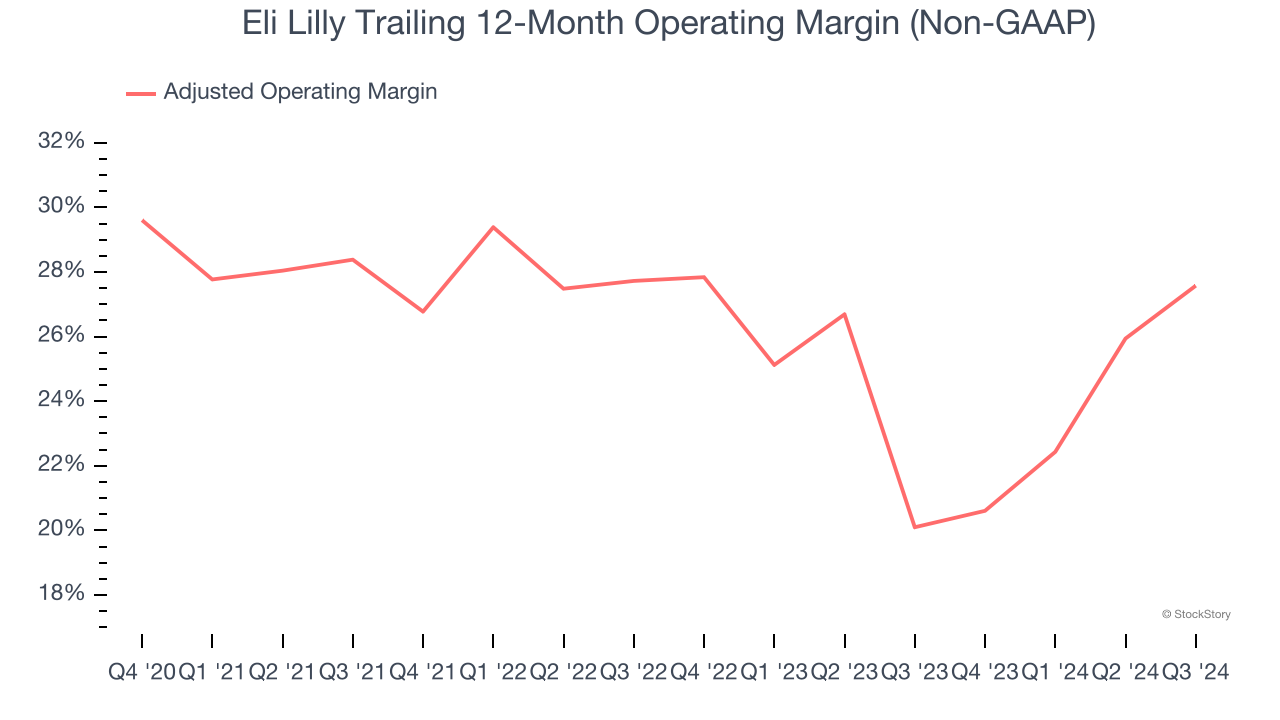
in line with the same quarter last year. This indicates the company’s overall cost structure has been relatively stable.
Earnings Per Share
Revenue trends explain a company’s historical growth, but the long-term change in earnings per share (EPS) points to the profitability of that growth – for example, a company could inflate its sales through excessive spending on advertising and promotions.
Eli Lilly’s EPS grew at an astounding 17.7% compounded annual growth rate over the last five years, higher than its 15.1% annualized revenue growth. However, this alone doesn’t tell us much about its business quality because its adjusted operating margin didn’t expand.
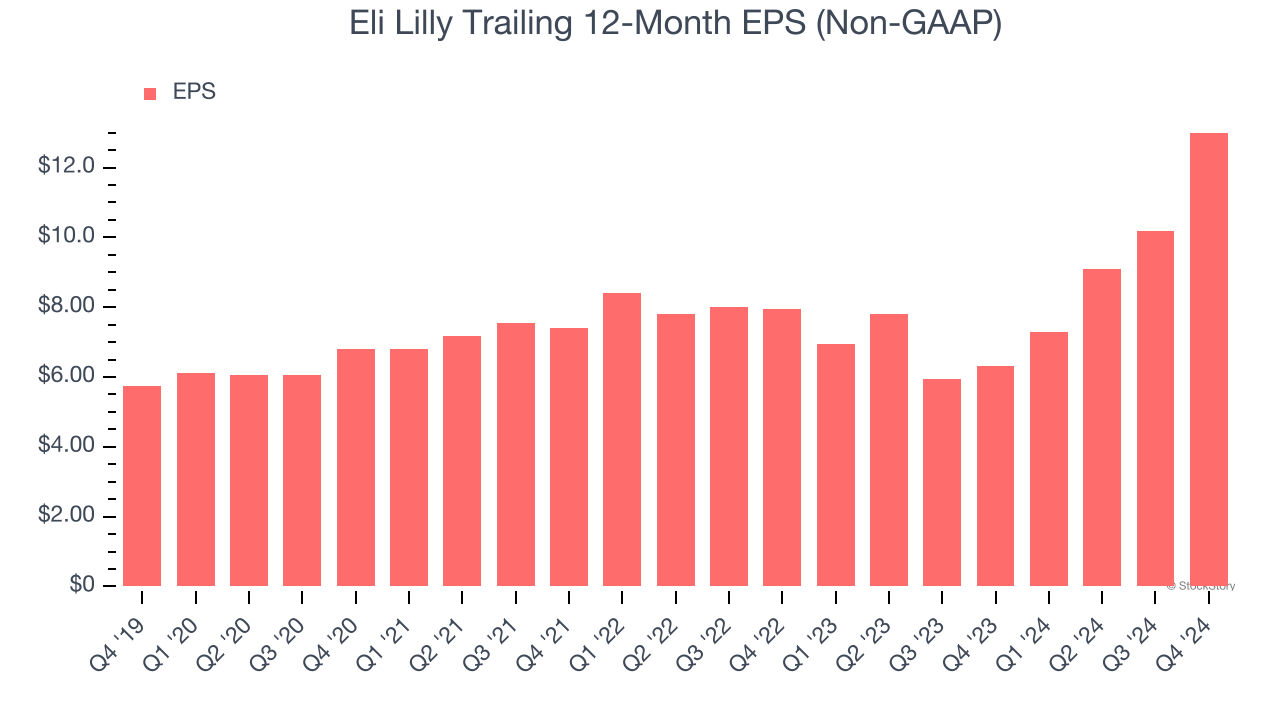
We can take a deeper look into Eli Lilly’s earnings quality to better understand the drivers of its performance. A five-year view shows that Eli Lilly has repurchased its stock, shrinking its share count by 1.3%. This tells us its EPS outperformed its revenue not because of increased operational efficiency but financial engineering, as buybacks boost per share earnings. 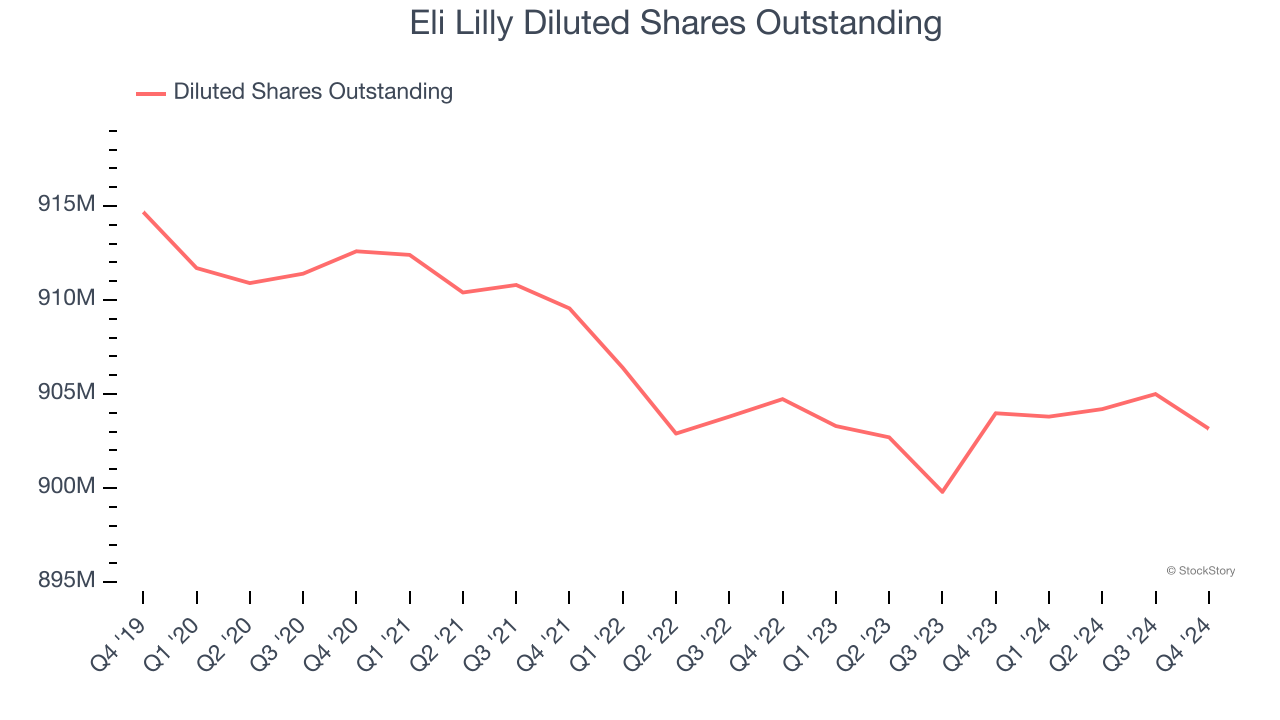
In Q4, Eli Lilly reported EPS at $5.32, up from $2.49 in the same quarter last year. This print beat analysts’ estimates by 4.7%. Over the next 12 months, Wall Street expects Eli Lilly’s full-year EPS of $13.00 to grow 83.9%.
Key Takeaways from Eli Lilly’s Q4 Results
It was encouraging to see Eli Lilly beat analysts’ full-year EPS guidance expectations this quarter. We were also glad its full-year revenue guidance came in slightly higher than Wall Street’s estimates. On the other hand, its revenue and EPS were both just in line with Wall Street’s estimates. Overall, this quarter was solid. The stock traded up 2.1% to $861.50 immediately following the results.
Is Eli Lilly an attractive investment opportunity right now? The latest quarter does matter, but not nearly as much as longer-term fundamentals and valuation, when deciding if the stock is a buy. We cover that in our actionable full research report which you can read here, it’s free.
